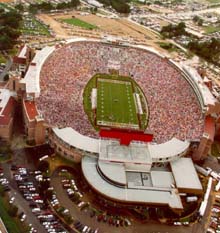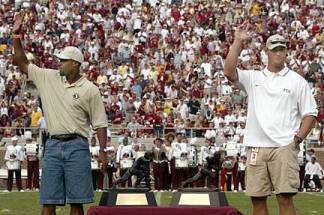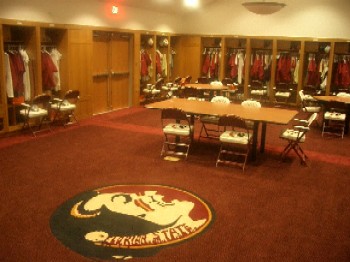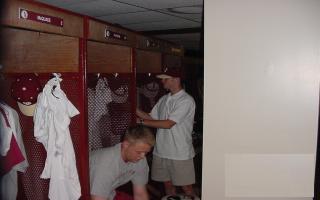
Doak Campbell Stadium in the mid-90s
By Bill Bunker
04/2004
This is the ninth and final installment in the series on Seminole Booster history by former FSU Sports Information Director Bill Bunker.
The Dynasty Campaign brings long-awaited athletic facility improvements to FSU
 |
Doak Campbell Stadium in the mid-90s |
Midway through the 1990s, Florida State's athletic community looked upon its recent history with justifiable pride. The Seminoles had joined the Atlantic Coast Conference in 1992 and in 1993 won their first national championship behind Heisman Trophy quarterback Charlie Ward.
Doak S. Campbell Stadium seemed to undergo annual expansions. Soon, it would be surrounded by The University Center and recognized as one of college football's greatest venues.
When the Board of Directors of Seminole Boosters, Inc., gathered early in 1995 to meet new FSU Athletics Director Dave Hart, they were unprepared for the disquieting message he delivered.
"We were just coming off the completion of the University Center complex. We thought our building program was pretty much finished," recalls Seminole Boosters President Andy Miller. "At the first meeting we had with Dave Hart and the Booster Board, he said, very tactfully, that we'd done a great job with the stadium, but other than that, FSU's athletic facilities were in dreadful shape, about as bad as any he had ever seen."
Hart, too, remembers the meeting and the reaction of the board.
"Well, the body language sent me a message, unspoken, like, 'Where did we find this guy?'" Hart said. "I told them I know that you probably don't understand why I would say that, but if you travel the areas our student-athletes travel you would agree. Most people come to the stadium on football Saturdays and sit in the gorgeous stadiums and skyboxes and think all is well, but I knew that all was not well, and that we should be prioritizing and insulating our future, particularly for the day when Bobby Bowden is no longer our head football coach."
 |
FSU's Two Heisman Winners in the 90's |
"It really kind of took us by surprise, because we had no idea," Miller said. "He told us that in his view the biggest concern was the football locker room, which he said might be the worst in college football. Then he talked about things like the aquatic center, track, golf and basketball, which was really a bad situation.
"We were responsive. When we started taking a closer look at things, we saw he was right. Track, swimming and golf were all in bad shape and we were falling behind in baseball. About that time a national college baseball magazine ranked all the stadiums in the he country, and we were not even in the top 25."
From this beginning came FSU's master plan for athletic facilities and a capital campaign, "The Dynasty Campaign," to pay not only for facilities, but also to significantly increase athletic scholarship endowments.
Bowden needed some, but not much, convincing on the need for new facilities.
"For all the success we've enjoyed under Bobby and prior to Bobby in establishing football tradition, we had maybe the worst football locker room environment that I had seen," Hart said. "Bobby, being who he is, didn't view it as a problem. I remember being on a plane to a spring booster meeting with him and saying, 'You know Bobby, we need to address the locker room.' He said, 'Why?' I explained to him the logic and so on, and a couple of days later he popped his head in my door and said, 'I've been thinking about that conversation we had. When can we move forward?'"
First came the plan.
"I asked our athletic staff to participate in building a master athletic facilities plan," Hart said. "We took a good 14 months to do an assessment of every sport we have, men's and women's, trying to see where we were in terms of budget, how we traveled, and commitment and facilities."
The final plan included a new soccer-softball complex, new football locker room, new golf clubhouse and teaching center, new basketball training facility, new athletic administration building with new weight room, training room, classrooms, offices and museum, a new aquatic center, a vastly improved track and field complex and major renovations to Tully Gym to include new locker room facilities for volleyball, as well as completing the tennis center by adding locker rooms and coaches' offices.
Seminole Boosters, Inc., wrestled with the problem of where to find the funds to turn lines on paper into concrete and steel. As with the University Center, some of the facilities filled academic as well as athletic needs.
"We met with Dave (Hart), we came up with a plan, did a needs assessment," Miller said. "We did a $32 million bond issue, which was enhanced by some university and state funding, and we launched the Dynasty Campaign in late 1998."
One question facing the Boosters as they planned Florida State's first capital campaign for athletics was how much they could expect to raise. The firm of Martz and Lundy was hired to do a feasibility study.
"Their report said the campaign was feasible, that we had a favorable image, and the Boosters did a good job, and so on and so forth," Miller said. "We asked them to test for $100 million, but they said based on their interviews and surveys and based on our demographics they saw $35 million as being feasible. This was $35 million in new money, in addition to the approximately $8 to $10 million that the annual fund was producing each year. We thanked them and went about our business.
"The way to organize a capital campaign is to seek out the large gifts first. Leadership gifts. And you try to raise at least half of what you want before you announce publicly what your campaign goals are. The idea being that you don't want to fail. You want momentum, and you want people to think this is successful. They want to be a part of something successful. So we went after our leadership gifts, and about two and a half years into the capital campaign we were already at $35 million. So we recommended to our board that we set a $70 million campaign goal for five years."
The campaign was announced to the public in the fall of 2000 with an extravaganza at the Leon County Civic Center. Major gifts continued to be the campaign focus and remained so until the final year when all Seminole Boosters were encouraged to contribute.
Serving as chairman of the Dynasty Campaign was Bowden, whose football success created and perpetuates the dynasty for which the campaign was named. Both in the early major gifts effort, and later in the public portion of the campaign, Bowden contributed much more than his name.
"As he has done in everything else, Bobby went above and beyond what we asked," Hart said. "Without exaggeration, over a four-year period we took some 600 people on a tour of our existing facilities, and every one of those opportunities included a visit with Bobby in his office, and I mean he did this during the season."
 |
New Baseball Locker Room after Renovation |
 |
Seminole Baseball Lockerroom from 1998 |
"We decided early on that instead of making multiple trips around the state we would put prospects on a plane and fly them up here," Miller said. "On a typical day we would show them around the facilities so they could see how bad they were. We would have a meeting with Coach Bowden as chairman of the Dynasty Campaign, then we would meet with Dave Hart and members of the staff to review the master facilities plan. Coach Bowden did a great job of working with us. He took a lot of responsibility and talked to donors when they came in, telling them we really needed help with these facilities.
"Our fund-raisers were very vital to the whole thing. The trip to Tallahassee was just the introduction. After that, the fund-raisers had to close the deal. Tom Carlson, Joel Padgett, Charlie Barnes, Debbie Derzypolski, Mike Bristol, Adam Corey and Jerry Kutz all did a great job. We're basically an annual fund-raising organization, and we added a $75 million campaign on top of that without adding any staff, so the effort was outstanding."
As the campaign progressed, Hart saw the working relationships between the Boosters and the athletic department staff grow closer.
"There's a genuine level of respect for the task at hand between the two organizations that have to work hand in glove and have done so," he said. "The planning and implementation of this master plan simply could not have happened if it weren't for that relationship."
The Dynasty Campaign was carefully organized and conducted. To recognize the larger gifts now being sought, a new donor category was established. Million-dollar contributors became Miccos, a Seminole word meaning chief or great leader. Many Miccos also signed on for the High Council to provide leadership and assistance in the campaign. Many of the new facilities would find new names attached.
"We went through all the facilities and listed the naming opportunities," Miller said. "It was difficult at times because some of these facilities hadn't even been designed yet. But, we knew we would have locker rooms and lockers and training rooms and offices and conferences rooms, so we just came up with a list of things and put numbers on them. Later on, we found we had undervalued some and overvalued others."
With the master plan in place, Dynasty Campaign under way and legislative and university help secured for multi-functional spaces, FSU's athletic facilities began to emerge. What appeared to be a random pattern of construction actually followed a schedule which allowed the athletic department and its component sports programs to function while their new homes rose around them.
Construction of the Scott Speicher Tennis Center and the Daisy Parker Flory Wing of the Moore Center in 1993-94 had given the program a running start, and the University Center would provide office space for the athletic department during the later stages of the plan.
First up was the soccer/softball complex. Although part of the master plan, it was funded with proceeds from the Seminole Boosters credit card program. Its centerpiece is the Mary Ann Stiles and Barry Smith Soccer/Softball Building.
"Our cornerstone in the master plan seven years ago was soccer/softball, very much by design," Hart said. "At that time I felt strongly, and President Sandy D'Alemberte concurred, that we needed to send a message and make a statement about our women's athletic programs. In order to facilitate that desire, before moving forward with other elements of the master plan, we wanted to get that project in place. We aggressively pursued that and were able to build what is still a state-of-the-art facility, very uniquely designed."
The Manny Garcia Football Locker Room was next, and that took some juggling.
"We asked the architects if we could do it in stages," Hart said. "We had established the footprint for the new Moore Center, but we obviously couldn't come in and bulldoze it. Could we build the new locker room and also move forward on the basketball training center prior to bulldozing that building because we have no place to practice basketball? Once we were convinced it could be done that way, we went to the bond market and borrowed $32 million against Dynasty Campaign pledges so we could get out of the gate with the basketball training center, knowing that all these pieces had to fall right for us not to displace any of these sports for any length of time."
In addition to the basketball center, the bond issue included the new Moore Center building and Dick Howser Stadium, but basketball quickly moved to the top of the priority list. As part of the master plan, but not included in the Dynasty Campaign, the Boosters contributed to renovations to the Leon County Civic Center. Completed in 1999, the upgraded arena provided FSU with a first-class playing facility accompanied by enhanced revenue streams through the sale of new luxury boxes.
The decision was made to construct the basketball training center adjacent to the Civic Center. Ground was broken in April 2001, and a year later the center opened - just in time to greet Leonard Hamilton, FSU's new basketball coach.
"Moving the basketball training center to the civic center is one of the best decisions we ever made," Miller said. "Our basketball practice facility was under the football stadium, and we felt like we had struggled enough in basketball. We needed to make a statement that basketball was important to Florida State."
In October, 2001, Florida State dedicated its new $5.6 million Dave Middleton Golf Center at the Don Veller Seminole Golf Course.
"We actually raised the money in cash and had some legislative and university help," Miller said. "There are business and hospitality school components in the Professional Golf Management program."
Once basketball moved to its new home, demolition began on the Moore Center. Hart and his staff found office space in the University Center, a weight room was set up in the old Florida High gym and the training room continued to operate in its old quarters.
"We constructed these phases first, though they are part of the new Moore Center," Hart said. "We moved first into the weight facility (named for Roger Holler) when it became functional (2003), then turned our attention to the new sports medicine area. I might add that we also have added a curriculum where students can train to be athletic trainers. That's part of the co-op with academics."
In April of this year, the Haggard Family Plaza at Dick Howser Stadium, which is nearing completion of a $12 million renovation, was dedicated. Included is the Griffin Family clubhouse, which compares favorably with major-league facilities. Other major contributors were DeVoe Moore and Steve and Yvonne Brown. The final piece of the plan currently under construction, the Moore Center, should be completed this fall.
Work on the track and field and aquatic facilities await decisions on their locations. The old Bim Stults Pool sits in mid-campus on prime classroom land, and the new medical school is squeezing the Mike Long Track. Although the track itself was reconfigured and resurfaced last year, there is a possibility that both complexes could be relocated off-campus near the golf course.
Meanwhile, the area around Campbell Stadium remains a construction site as it has been for the past decade. Scattered among the headliners of the Dynasty Campaign are a number of projects that would attract more attention during normal times. Tully Gym received a $2.2 million makeover for volleyball.
Langford Green, Williams Plaza and the sculpture, "Unconquered," provide a stunning front door for the University Center, while the "Sportsmanship" statue on the Al Strum Plaza enhances the west side. Thanks to the contribution of the Bill Peterson family, Seminole football players enter and leave the stadium through "Pete's Posts," as did their predecessors who played for the former FSU coach.
At Hart's urging, the Boosters financed the double-decked Varsity Club box in the stadium's northwest corner, providing a rallying point and meeting place for former Seminole athletes.
Late in the Dynasty Campaign, donors from $1,000 to $25,000 were offered bricks on the Ruth and Les Akers Plaza, which will connect the new Moore Center building with Dick Howser Stadium, and contributions are now being accepted for bricks on Legacy Walk, an extension of the Akers Plaza which will weave through and around the athletic complex.
The Dynasty Campaign concluded as it began, with a gala celebration at the Civic Center. Miccos were escorted from limos. Former FSU footballers Burt Reynolds and Paul Gleason headed up a Las Vegas style act. And Seminole Boosters Executive Director Charlie Barnes announced the final tally -- $75,311,612.72 -- more than $5 million more than the stated goal.
Hart looks back on the decade with pride.
"We said we would like to plan and implement the campaign and finish it within a five-year window, go to the bond market to borrow money against the pledges, and in a ten-year window finish the plan," he said. "That is extraordinarily aggressive, because we were talking about $110 million in facility enhancement. In talking to peers and people in the profession, many thought we were biting off more than we could chew because some of these projects were so major.
"The typical way to go about this would be to commit to one project, spend a few years, raise the money, do the project and then move on to the next one. Instead, we had many of these projects going on simultaneously. This is an effort that many, many people contributed to collectively, and everyone should feel proud that we are close to pulling it off."
Decisions on track and swimming loom in the near future. The Moore Center nears completion, and things should be tidied up a bit before the 2004 football season begins, but items such as the atrium museum, the Mike Loynd Tradition Room at Howser Stadium, the graphics package that will pull everything together and Legacy Walk will require more work and perhaps more money, but Florida State enters the new ACC with an athletic complex equal or superior to its opponents.
Since completion of the Dynasty Campaign Seminole Boosters, Inc., has renewed its efforts to increase membership. In 2003, 2,139 additional members were added, and the campaign continues in 2004. As FSU's football dynasty grew during the past decade - in 1999, the Seminole became the first team in history to begin and end a season ranked No. 1 without relinquishing the honor - so, too, did the Boosters' appeal expand from its Tallahassee roots.
Beginning in 1995 with Jupiter's Carl Domino, six of the past 10 chairmen have come from outside Tallahassee: Domino (1995); Jim Kirk, Ocala (1996); Sherman Henderson, Louisville, Ky. (1998); Gary Walsingham, Panama City (2000); Raymond Cottrell, Orlando (2001, and Bob Fohl, Orlando (2003), though Fohl has moved to Tallahassee.
Tallahasseeans included Dr. Joe Camps (1997), Don Reinhard (1999), Ron Hobbs (2002), and current chairman Chris Kraft.
With an eye firmly fixed on the future, Miller summed up the past 10 years. ";During this era a lot of things happened. A lot of buildings got built, a lot of money got raised. The ACC expanded. Leonard Hamilton was hired. We redid the civic center. The facilities master plan. The Dynasty Campaign. A lot of activity. A lot of things happened," he said.
But, what of the feasibility study which predicted the Dynasty Campaign would tap out at $35 million?
"Later on, Martz & Lundy made the statement that they noticed the absence of really, really large contributors, but they said we had a great number of people in our program who gave more than you would anticipate them to be able to give," Miller said. "They said it showed a measure of loyalty that was unique to Florida State."